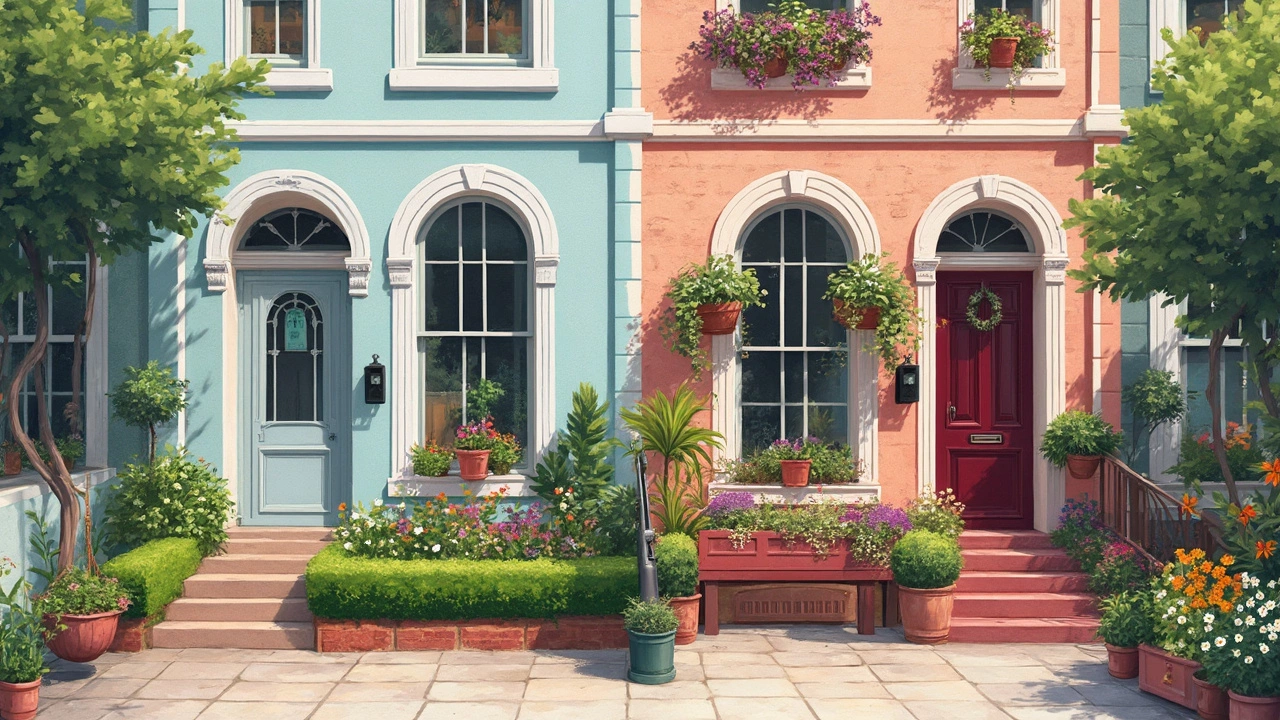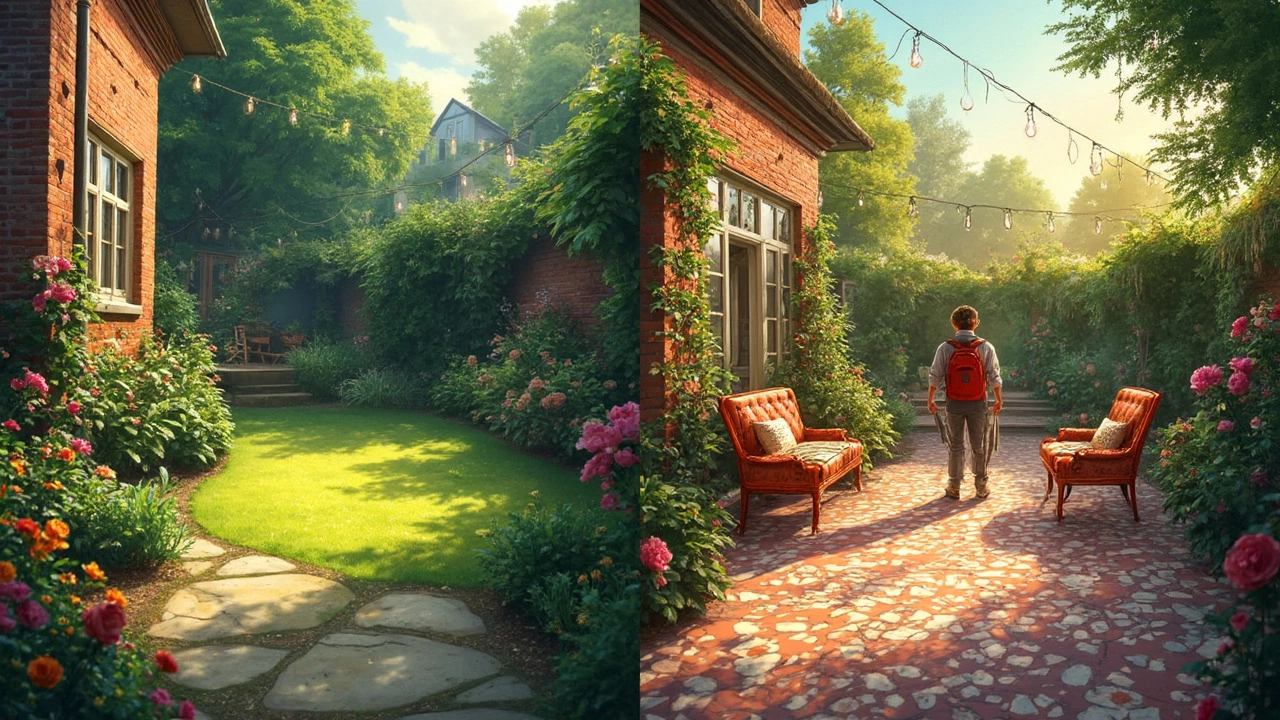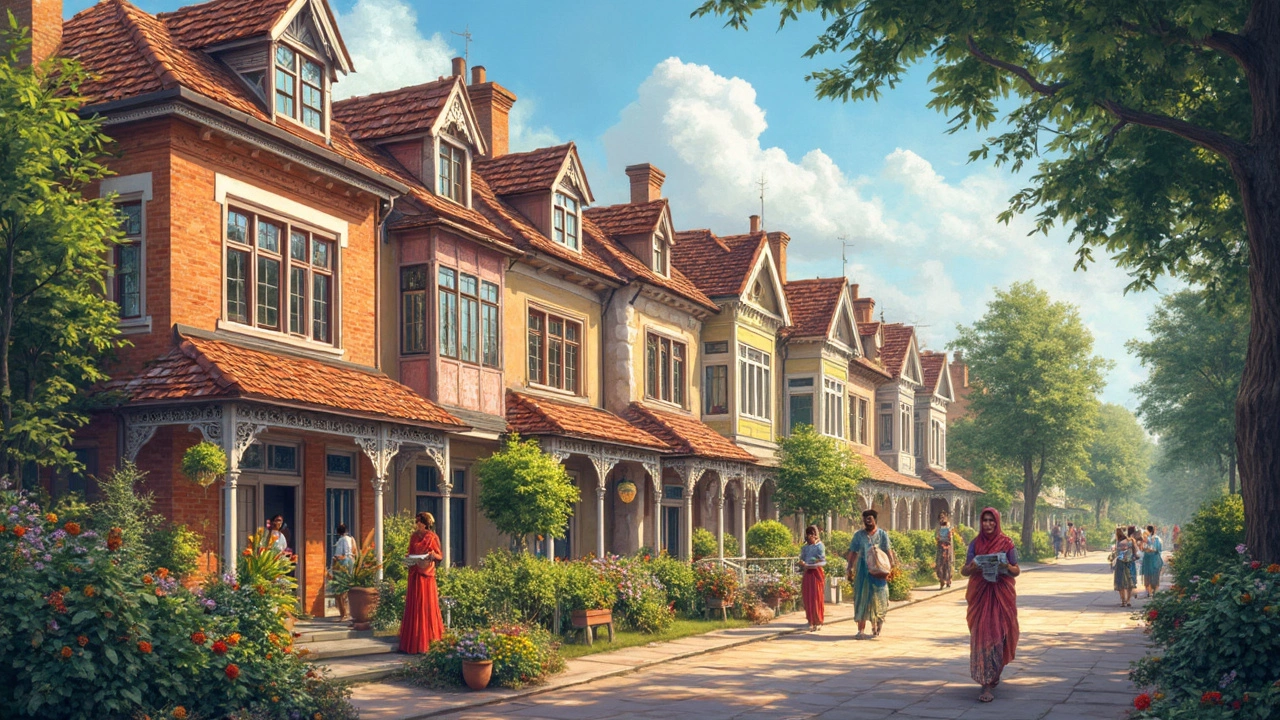If you've ever walked down a street in London or Bath and wondered why some terraces look so grand and others feel a bit more cozy, you're not alone. There’s a world of difference between Georgian and Victorian terraces, and those differences totally affect how you can use your garden space.
Here’s the straight-up answer: Georgian terraces stick to rules—symmetry, balanced windows, neat doorways. Think straight lines, simple shapes, and less clutter on the outside. Victorian terraces? They come a few decades later and like to show off. Expect fancy brickwork, bay windows, and iron railings. So if you’re unsure which is which, just look for the basics.
Now, why does this matter for you and your little piece of outdoor space? Simple: the design of these homes shapes everything, from how much sunlight your garden gets to where you can put your favourite plants or pots.
- Classic Signs: Spotting a Georgian or Victorian Terrace
- Why Layout Matters for Garden Space
- Front Gardens, Back Yards, and Where Plants Thrive
- Decor Details: From Ironwork to Doorways
- Gardening Tips For Each Terrace Style
Classic Signs: Spotting a Georgian or Victorian Terrace
So how do you tell if you're looking at a Georgian or a Victorian terrace? Here's the gist: Georgian terraces, built roughly from 1714 to 1830, are all about straight lines and symmetry. Houses usually line up perfectly, and every window is the same size and shape. If the doors and windows seem like they could have been measured with a ruler, you're probably looking at Georgian.
Most Georgian terraces have flat facades (no pop-out bay windows), and they're often finished with pale stone or brick. You might notice details like fan-shaped windows above the front door—super common for this era. And most are set back behind small iron railings or a low wall, with a neat front path leading to the door.
On the other hand, Victorian terraces (built from about 1837 to 1901) love variety and a bit of drama. You'll spot tall, narrow houses with steep-pitched roofs. Bay windows are everywhere, sticking out into the street and grabbing extra light for the inside. Expect fancy brickwork, bold door colors, and lots of decorative ironwork along the steps or in the front garden. Sometimes, you'll even see stained glass in the doors or above them, which wasn’t really a Georgian thing.
Here's a quick way to spot the main differences:
- Georgian terraces line up like soldiers—symmetrical and elegant with plain facades.
- Victorian terraces break things up with bays, colored bricks, and decorative railings—lots more character.
Next time you walk past a row of homes, look out for these details. Spotting a Victorian terrace versus a Georgian terrace comes down to the shapes, lines, and how much the builder wanted to show off.
Why Layout Matters for Garden Space
The basic layout of a terrace house sets the stage for your gardening dreams. Georgian terraces, built mainly from the early 1700s to early 1800s, were famous for their deep footprints. That means the homes were long from front to back but often pretty narrow. In most cases, you got a decently sized back yard or garden—sometimes even stretching out a lot further than newer homes on the same street. Good news if you like fruit trees or space for outdoor seating.
Victorian terraces, on the other hand, were usually built as cities got crowded during Queen Victoria’s time. Home builders squeezed as many houses as they could into available plots. The houses were often shallower, and the gardens got the short end of the stick. If there’s any back garden at all, it’s usually short and tucked in behind the house or shared with neighbors. Some just have a concrete yard, especially in dense city areas.
Another difference? Access. Georgian terraces sometimes come with a side “mews” or a back lane—letting you wheel a compost bin in and out without dragging it through your kitchen. Victorian terraces mostly keep things boxed in. Back gates are rare, so you might be carrying bags of soil through the hallway if you’re not careful.
- Georgian layouts give you more room to plan a proper vegetable patch or even add a greenhouse.
- Victorian gardens need a bit more creativity—think vertical planters, window boxes, or container gardening.
- If sunlight is your main goal, check which way your terrace faces. Georgian back gardens tend to get lots of natural light. Victorians, especially in rows, can end up shaded by other houses.
The upshot: Your Victorian terrace or Georgian home isn’t just a style statement. It defines your garden space, how much you can plant, and even what growing tricks you’ll need in your toolkit.

Front Gardens, Back Yards, and Where Plants Thrive
Here’s the fun part for gardeners: Georgian and Victorian terraces treat their outdoor space very differently, and it affects what you can actually do with plants. Georgian terraces, older and more formal, often come with a small private front garden, sometimes fenced by low stone walls or classic iron railings. Back in the day, these gardens showed status—neat hedges, maybe a rose bush or two, nothing wild.
Victorian terraces, on the other hand, were built when cities got crowded. Lots of these homes lost their front gardens as space shrank. Instead, you’ll usually see small yards at the back, often paved over. Not so much for looks—more for laundry or storage—and sometimes called "back-to-backs" if there’s not even a true back yard. Does that mean you can’t garden? Not at all. But you’ve got to work with what you have.
“Victorian terraces made do with less land, so every square foot counts for today’s gardener. But creative planting, window boxes, and containers can make a huge difference.” – The Royal Horticultural Society
This shouldn’t put you off. If you’ve got a Georgian terrace, luck’s on your side—you might have a strip of soil out front and a more private, leafy garden at the back. For Victorians, it’s all about using pots, vertical gardens, window boxes, or even a few clever herbs near the steps.
| Feature | Georgian Terrace | Victorian Terrace |
|---|---|---|
| Front Garden Size | Medium (private, formal) | Small to none (sometimes only a paved area) |
| Back Garden/Yard | Larger, green, for leisure and planting | Often small, sometimes paved or hard to access |
| Sunlight | Good (especially south-facing rows) | Can be limited by close neighbours or extensions |
Quick tips: For Georgian front gardens, keep things tidy and classic—low box hedges or lavender do well. For Victorian yards, think vertical—hanging pots, wall planters, or climbing beans and tomatoes. And if it’s all concrete? Raised beds work wonders. Bottom line: no matter the era, some smart planting choices can make any terrace feel like home.
Decor Details: From Ironwork to Doorways
The easiest way to tell if you're standing in front of a Victorian terrace or a Georgian one is to look closely at the details. Each era had its own favorite bits of decoration—some practical, some just for show.
Victorian homes love to flex with things like fancy tiles, decorative brickwork, and cast-iron railings. Bay windows pop out into the street, adding extra room and a spot for indoor plants to catch some light. You’ll usually see small front gardens with low walls topped by ornate metalwork—builders back then wanted houses to stand out, not just fit in.
Georgian terraces go for simpler, more classic vibes. Doors sit right in the middle, surrounded by slim columns or a fanlight window above to let in daylight. Sash windows are arranged in neat rows—usually five across—sticking to a clean design. Forget about super decorative touches; everything feels balanced and even. Imagine a big, plain door, wide steps, and not much in the way of frills.
The difference even shows up in the numbers. Georgian homes were often built between 1714 and 1830, while Victorian terraces took over from 1837 to 1901. That’s why you see so much more wild detail on Victorian streets.
| Feature | Georgian Terrace | Victorian Terrace |
|---|---|---|
| Main Door | Centered, fanlight window, plain wood | Off-center, stained glass, decorative arch |
| Windows | Flat sash, aligned, smaller upstairs | Bay windows, sometimes stained glass |
| Ironwork | Rare or plain railings | Ornate, cast-iron fences and gates |
| Garden Borders | No fences or very low walls | Decorative iron railings on short brick walls |
If you’re planning on doing anything with your front or back garden, look at these details first. Original features can affect whether you can add new railings, paint the front door a wild color, or plant a hedge. In many listed terraces, you might need special permission to change things, especially if you're on a street where most homes still have their original look. So before grabbing a paintbrush or swapping out your old railings, check how others on your street have handled it, and if needed, ask your local council what’s allowed. It’ll save headaches and keep your street looking sharp.

Gardening Tips For Each Terrace Style
Getting the most from your terrace garden starts with knowing what you’re working with. Georgian and Victorian terraces bring their own quirks, so let’s break down what actually works best for each style.
Victorian terrace homes usually come with narrow but surprisingly long back yards. Sometimes these little spaces even run behind multiple homes. Why does that matter? They’re prime for creating "garden rooms" or splitting your area into zones: one for a veggie patch, another for sitting with a coffee. Victorians loved ferns and evergreens, and you’ll score extra points by mixing climbing roses with cast iron planters or painted pots—both of which pop against brick. If you’re short on sunlight, which is pretty common, try shade-lovers like hostas, fuchsias, or even foxgloves if you’ve got pets or kids who won’t nibble.
Georgian terraces usually face the street with neat, boxy front gardens and slightly larger back gardens (when you get one). Typical features: straight borders, central paths, lots of symmetry. The trick with Georgian gardens is to keep things formal but not stiff. Use clipped box or lavender for edges, fill beds with tulips in spring, or even try dwarf fruit trees in tubs. These gardens often get more light, so sun-happy options like herbs and salvias thrive. Want a fast win? Stick to whites and blues in your main plant selection—they’ll play up those elegant lines rather than making the place look busy.
| Terrace Type | Garden Size | Main Tips | Best Plants |
|---|---|---|---|
| Georgian | Often larger, square layout | Go formal and symmetrical, use neat hedges, try a central path | Lavender, tulips, dwarf fruit trees, salvias |
| Victorian | Long and narrow | Split into zones, add climbers, use pots and shady plants | Ferns, hostas, foxgloves, climbing roses, fuchsias |
One quick tip: drainage can be an issue in older terraces, especially in Victorian ones with clay soil. If you’re laying beds or turf, fork in some grit or organic matter to stop your garden turning into a swamp after heavy rain. For tiny terraces, vertical gardening—like wall-mounted herb racks—is a solid move. Georgian homes often have taller boundary walls, so climbing options (think clematis or jasmine) can help soften those hard edges while giving you more privacy.
Think about privacy, too. Both terrace styles can put you up close with neighbors. In Georgian street-facing gardens, short box hedges look neat but don’t keep out prying eyes. Modern twist: try a living willow screen or upright trellis, especially if you want a little more peace in your outdoor lounge spot.
Bottom line: work with your terrace, not against it. Embrace the quirks—whether it’s a grand Georgian façade or a snug Victorian side return. You’ll end up with a garden that feels right for the house and for your day-to-day life.

